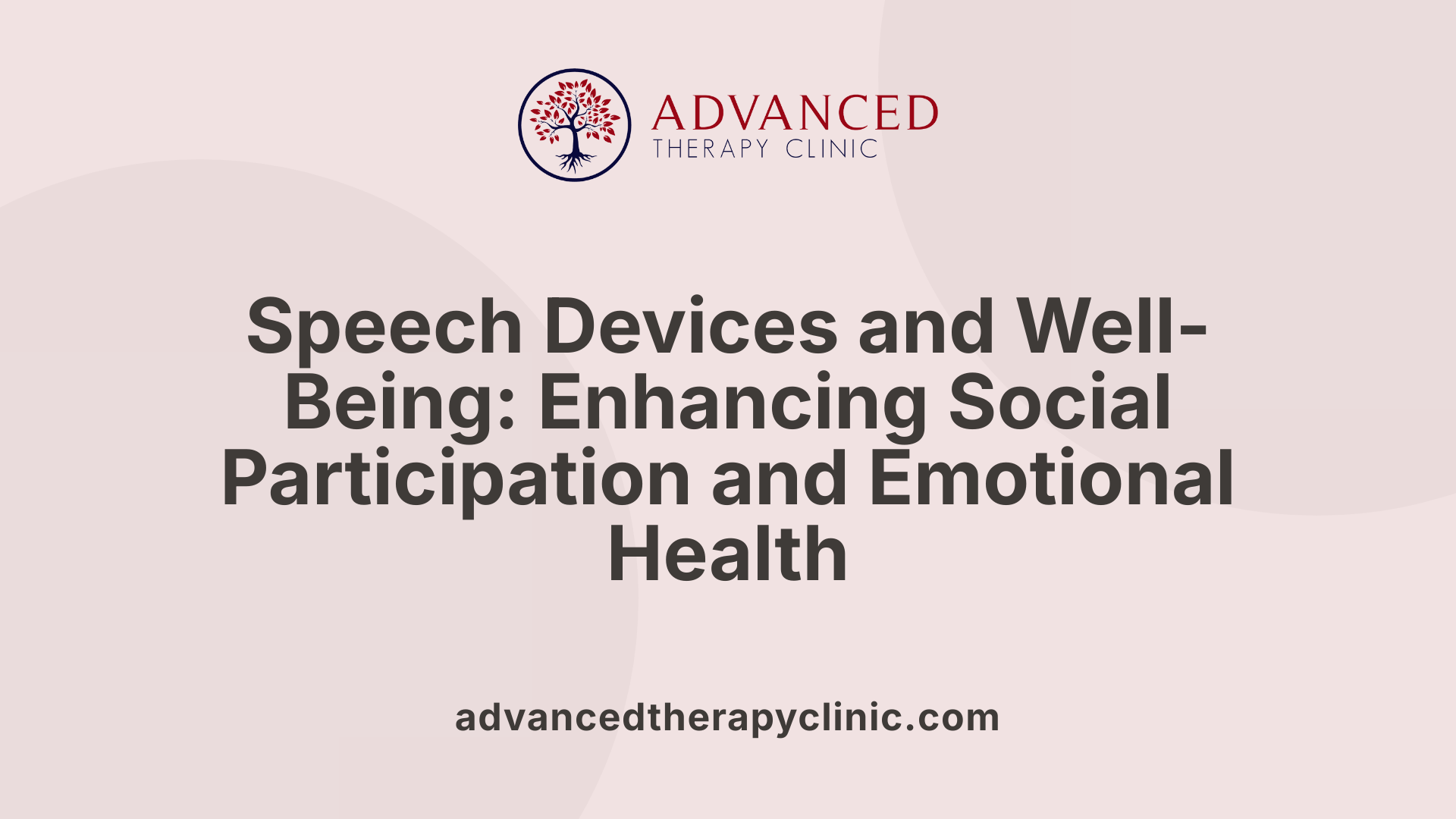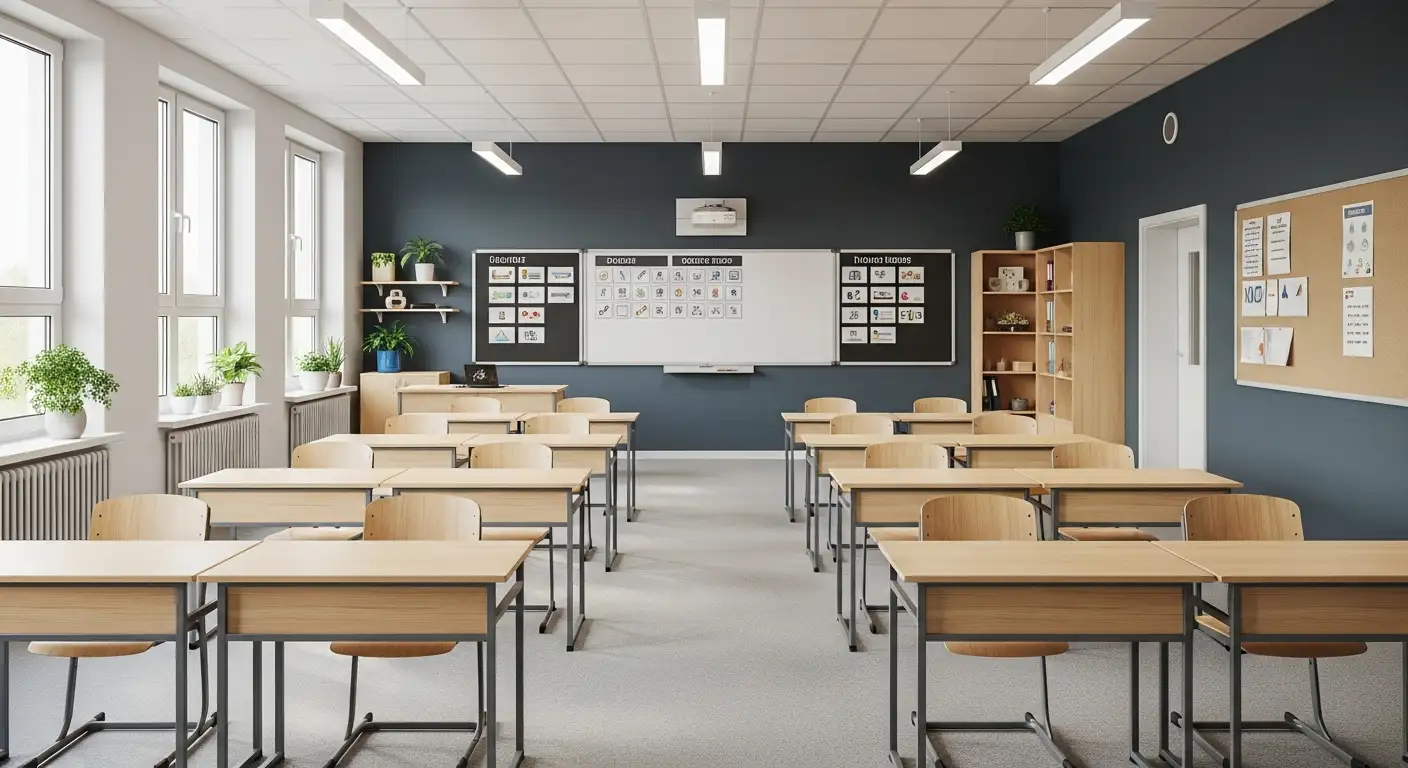The Benefits of Speech Devices in Supporting Communication


Understanding the Power of Speech Devices in Enhancing Communication
Speech devices, encompassing augmentative and alternative communication (AAC) tools, play a crucial role in supporting individuals of all ages who face speech and language challenges. These devices range from simple gestures to sophisticated speech-generating systems, providing diverse options tailored to individual needs. Their primary goal is to reduce communication barriers, foster social participation, and promote independence, ultimately improving quality of life for users.
Overview of AAC and Its Spectrum of Options

What are augmentative and alternative communication (AAC) devices and how do they support speech development?
Augmentative and alternative communication, or AAC, includes all the methods and tools used to help people communicate when they cannot speak or have difficulty doing so. These devices and strategies support both expressive and receptive language skills, making it easier for individuals to share their needs, thoughts, and feelings.
AAC encompasses a wide range of options, from simple no-tech tools like gestures and facial expressions to complex high-tech devices such as tablets equipped with speech-generating applications. These tools are tailored to match each person’s abilities, preferences, and specific needs.
Using AAC devices helps foster language development by providing clear, efficient ways to communicate. They reduce frustrations that can occur when someone is unable to express themselves and encourage social interactions with family, friends, and peers.
No-tech, low-tech, and high-tech AAC options vary in complexity and accessibility. No-tech methods include gestures, facial expressions, and signs. Low-tech options might involve picture boards, communication books, or writing. High-tech solutions consist of electronic devices, like speech-generating tablets and specialized apps, which produce spoken words or display symbols.
Within AAC, there are aided methods—those requiring physical support like picture systems or electronic devices—and unaided methods that do not need external tools, such as sign language or body language.
Overall, AAC tools are vital for enabling effective communication, supporting speech development, and helping individuals lead more independent lives. Their use is beneficial across all ages and can be introduced early in development to maximize benefits.
The Role of Speech-Language Pathologists in AAC Implementation

When and how should speech devices be implemented to support communication most effectively?
Speech devices are best introduced after a thorough assessment of the individual's unique communication needs and abilities. This assessment is typically carried out by a speech-language pathologist (SLP), who considers the person’s motor skills, cognitive level, sensory needs, and communication goals.
The process involves selecting suitable AAC options, which can range from simple gestures and picture boards to sophisticated speech-generating devices (SGDs). The SLP ensures that the chosen device aligns with the individual’s current skills and promotes naturalistic use in daily life.
Implementation should focus on integrating the device into everyday routines, including play, social interactions, and educational activities. Consistent use in familiar contexts helps the user become comfortable and proficient with the device.
Training both the individual and their communication partners—such as family members, teachers, and friends—is crucial. This training covers device operation, vocabulary development, and effective communication strategies.
Modeling device use during interactions encourages the user to learn how to express themselves confidently. Emphasizing core vocabulary—basic words like
Supporting Speech Development and Overcoming Myths

What misconceptions exist about the impact of speech devices on natural speech development?
A common misunderstanding is that using speech-generating devices or other AAC tools will hinder or prevent the development of natural speech. However, research consistently shows that AAC actually supports and can improve speech skills. These devices provide opportunities for practice, motivation, and cues that promote verbal learning. Many believe that children or adults need to reach certain cognitive or developmental milestones before they can start using AAC, but this is not true. AAC can be introduced at any age or stage of speech development, tailored to the individual's needs.
Some assume that only simple or low-tech devices should be attempted first, with high-tech options reserved for later stages. Yet, evidence indicates that high-tech AAC devices — like tablets with speech apps — can be engaging and effective from the outset, and do not impede natural speech development.
Another common myth is that AAC is only for people who are completely non-verbal or who cannot speak at all. In reality, AAC is versatile and beneficial for individuals with various speech abilities, including those with some words or partial speech. It can support or enhance verbal communication rather than replace it.
Overall, these misconceptions often stem from outdated beliefs and misunderstandings about AAC. Modern research highlights that AAC tools are adaptable, supportive, and can even promote speech production, helping individuals communicate more effectively and confidently.
Early Intervention and Its Impact on Language Skills

How do speech devices support the development of communication skills?
Speech devices play a vital role in helping individuals, particularly children, develop effective communication abilities. These tools provide alternative ways to express themselves, such as through gestures, picture exchange systems (PECS), or speech-generating devices (SGDs). When introduced early, they serve not only as a means of immediate communication but also as a foundation for learning language, literacy, and social skills.
Professionals like speech-language pathologists (SLPs) tailor these devices to each person’s needs, making sure they are accessible and appropriate for their age and abilities. Using AAC devices can reduce frustration caused by the inability to communicate, which often leads to behavioral challenges. Instead, children learn to practice language in engaging ways, encouraging natural speech development.
Integrating AAC into daily routines—supported by families, teachers, and therapists—helps children use spoken language alongside augmentative methods. Over time, many children show improvements in speech clarity, vocabulary, and sentence structure. The combination of AAC and traditional speech therapy creates a powerful environment for language growth.
Research supports that early AAC intervention is linked with better communication outcomes. It fosters social interactions, helps children connect with others, and increases their confidence. Overall, speech devices are valuable tools that promote expressive language, facilitate social participation, and support long-term developmental milestones.
Benefits of Speech Devices Across the Lifespan
How are speech-generating devices (SGDs) used in children, adults, and aging populations?
Speech-generating devices serve individuals at all ages, from young children learning to communicate to older adults experiencing progressive speech difficulties. In children, especially those with autism, cerebral palsy, or developmental delays, SGDs help promote early language acquisition and support academic and social participation. For adults with conditions such as stroke-induced aphasia, neurodegenerative diseases like Parkinson’s or ALS, and cognitive-communication disorders like dementia, SGDs maintain and enhance communication, fostering independence and social connections. Older adults facing declining speech abilities benefit from these tools to reduce social isolation, participate in daily routines, and express needs effectively.
How do speech devices support independence and social participation?
Speech devices amplify an individual’s ability to communicate, which is fundamental for social engagement and personal independence. They enable users to participate actively in conversations, ask for help, and share their thoughts and feelings. For children, this fosters strong peer relationships and school involvement. Adults and seniors can participate fully in social activities, family interactions, and community events, reducing feelings of frustration or exclusion. By providing reliable means of expression, speech devices empower individuals to advocate for themselves and build meaningful relationships.
How can SGDs support different diagnoses?
Speech-generating devices are versatile tools tailored to various conditions. For individuals with autism, SGDs encourage spontaneous communication, facilitate language growth, and support social skills. Those with cerebral palsy or motor impairments can access SGDs through adapted controls, such as eye-tracking or switch systems, to overcome movement challenges. For speech-related disorders like aphasia, SGDs aid in regaining vocabulary and sentence construction. People with neurodegenerative diseases like Parkinson’s or ALS benefit from early device implementation, helping preserve communication even as motor functions decline. Children with Childhood Apraxia of Speech or phonological disorders find SGDs useful in reducing frustration and supporting speech therapy goals.
| Population | Device Usage | Examples of Conditions | Benefits |
|---|---|---|---|
| Children | Early introduction of high-tech or low-tech tools | Autism, cerebral palsy, speech delay | Language development, social skills, academic participation |
| Adults | Assistive communication at work and social settings | Stroke, aphasia, traumatic brain injury | Independence, social engagement, emotional well-being |
| Aging populations | Aid in maintaining social connections | Parkinson’s, Alzheimer’s, neurodegenerative disorders | Reducing isolation, supporting daily communication |
How do speech devices contribute to overall quality of life?
Speech devices improve quality of life by giving individuals a voice, increasing their ability to express wants, needs, and personality. They help reduce daily frustrations, support participation in family and community activities, and foster emotional well-being. The confidence gained from effective communication often encourages greater independence and social integration, leading to improved self-esteem. Early and ongoing access to SGDs can also support language growth, sustain speech abilities longer, and prepare individuals for various life stages.
Research consistently shows that speech-generating devices and other AAC tools do not hinder speech development; instead, they often support and enhance it. Studies with children, including those with autism, demonstrate accelerated language skills and improved social interactions when these devices are introduced early with professional guidance. Whether for children learning to speak or adults maintaining communication amid health changes, SGDs are vital for promoting autonomy, connection, and a better quality of life across the lifespan.
Technological Advances and Features of Modern Speech Devices

What features and advantages do various types of speech devices and AAC tools offer?
Modern speech devices and AAC tools are designed to be highly adaptable to meet the diverse needs of users, supporting both early intervention and ongoing communication development.
High-tech AAC devices, such as speech-generating devices and apps like Proloquo2Go, TouchChat, and LAMP Words for Life, are customizable and user-friendly. They enable personalization of vocabulary, allowing individuals to access words, phrases, and symbols that are most relevant to their daily lives.
These devices often feature natural-sounding voices that improve with software updates, making communication more realistic and engaging. The interfaces are designed to be intuitive, helping users navigate easily whether they are children, adults, or individuals with cognitive or motor challenges.
Integration with smartphones and tablets enhances portability, giving users the flexibility to communicate in different environments—from at home to school or work. Many devices are equipped with additional features such as environmental control options, eye-tracking technology, and accessories that support users with limited movement.
Advanced features support complex language functions like expressing opinions, making requests, asking questions, and participating in social routines. This versatility enables users to participate more fully in conversations and social activities.
Overall, these technological innovations make modern speech devices powerful tools that foster independence, boost confidence, and expand communication possibilities for individuals with various abilities and conditions.
The Impact of Speech Devices on Social and Emotional Well-being

How do speech devices support social interactions and emotional well-being?
Speech devices play a crucial role in enhancing social interactions and emotional health for individuals with speech and communication challenges. By providing a reliable way to express thoughts, feelings, and ideas, these tools help users engage more fully in conversations with family, friends, and peers.
Using a speech device, whether it is a high-tech app on a tablet or a simple picture-based communication board, empowers individuals to participate actively in social activities, classroom discussions, and community events. This sense of participation fosters stronger relationships and helps reduce feelings of isolation or loneliness.
Moreover, speech devices contribute to building confidence and independence. As users become more able to express themselves clearly, they often experience improvements in self-esteem and a sense of control over their social and daily lives. These positive feelings support overall emotional well-being.
By reducing communication barriers, speech devices also help lessen frustrations and behavioral issues that commonly arise when individuals are unable to convey their needs or emotions effectively. When frustration diminishes, behavioral challenges often decrease, leading to a more positive environment for everyone.
In summary, speech devices promote social inclusion, facilitate meaningful interactions, and contribute to emotional stability, allowing individuals with communication difficulties to lead more engaged, confident, and fulfilling lives.
Conclusion: Embracing Speech Devices for Better Outcomes
Why is speech important in communication?
Speech is essential because it allows people to convey thoughts, feelings, needs, and ideas clearly and efficiently. It enables understanding, helps build relationships, and supports social participation. When individuals cannot speak effectively, they often experience frustration and social isolation. Speech also plays a key role in education, work, and personal growth, serving as a foundation for active engagement in society.
Benefits of AAC and speech devices
Augmentative and alternative communication (AAC) methods—including no-tech gestures and high-tech speech-generating devices—provide vital support for individuals of all ages with speech or language difficulties. These tools remove communication barriers, fostering independence, self-esteem, and social involvement.
Research consistently shows that using AAC does not hinder speech development; in many cases, it supports improved language skills and reduces frustration. Early access to AAC can significantly enhance a child’s ability to develop expressive and receptive language, contributing to better academic and social outcomes.
The importance of early intervention
Introducing AAC early when speech or language delays are noticed is crucial. For children at risk—such as those with autism spectrum disorder, cerebral palsy, or Down syndrome—early AAC support can accelerate language learning and help children reach developmental milestones. The earlier intervention occurs, the greater the chance of fostering effective communication skills that can evolve alongside natural speech.
Role of professionals and families
Speech-language pathologists and other professionals play a vital role in assessing needs, recommending appropriate AAC tools, and providing ongoing training. Their expertise ensures that individuals use communication devices effectively and comfortably.
Families and caregivers are equally important. By modeling AAC use during daily routines, creating supportive environments, and encouraging social interaction, they help maximize the benefits of communication devices. Together, professional support and active family involvement pave the way for improved communication outcomes and a higher quality of life.
Harnessing the Power of Speech Devices for a Connected Future
In conclusion, speech devices—from simple gesture-based systems to advanced speech-generating devices—are transformative tools that greatly enhance communication for individuals facing speech and language challenges. Their benefits span across the lifespan, supporting early development, fostering independence, and improving social participation and emotional well-being. Early intervention, professional guidance, and continuous support are crucial to maximizing their potential. Dispelling myths and misconceptions, current research validates the role of speech devices as empowering aids rather than barriers, offering hope and improved quality of life for millions. Embracing these innovative tools promises a more inclusive, connected future where everyone can share their voice and engage meaningfully in society.
References
- Augmentative and Alternative Communication (AAC) - ASHA
- 9 Signs You Might Benefit From A Communication Device
- Communication Benefits of AAC - Plural Publishing
- Why Speech-Generating Devices Should Be Accessible to All
- Support for AAC Use in Preschool, and Growth in Language Skills ...
- Augmentative and Alternative Communication in Speech Therapy
- AAC Devices for Autism: Helping Parents Boost Communication
Recent articles

The Benefits of ABA Therapy for Sibling Relationships and Family Bonds
Strengthening Family Ties Through Applied Behavior Analysis

How Speech Therapy Assists with Improving Verbal and Nonverbal Communication
Unlocking Communication Potential: The Role of Speech Therapy

Supporting Autism During Transitions
Strategies and Therapies to Navigate Transitions for Children with Autism

Low-Functioning Autism
Understanding Support and Therapies for Autism Spectrum Disorder Level 3

How Speech Devices Enhance Communication for Nonverbal Children
Transforming Communication: The Role of Speech Devices for Nonverbal Children

TEACCH Method For Autism
Comprehensive Therapeutic Approaches for Autism Spectrum Disorder

